


 |
November 29, 2008: Barcelona (Day 2) |
 |
November 27, 2008: Copenhagen (Day 2) |
 |
Return to the Europe/Cruise Trip Index |
Copenhagen to Barcelona
|
|
The flight itself was uneventful- about a three-hour flight as I recall.
From the Barcelona Airport to the Axel Hotel
|
|
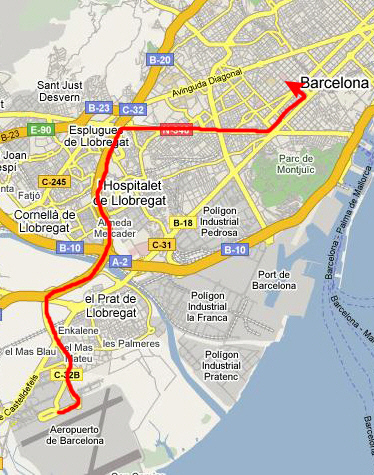 |
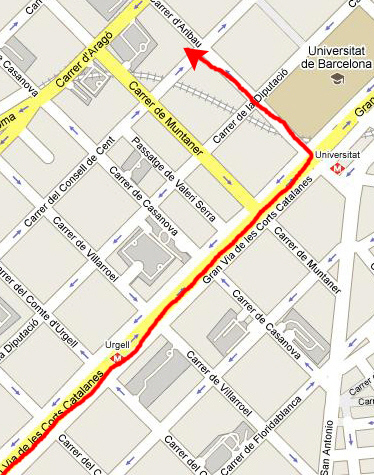 |
Our travel agent had booked the hotel months ago, so we could relax on the drive into the city. The route to the hotel was pretty direct. At left is a high-level view of the route from the airport, and at the right is a view of the last few blocks.
We passed a number of very interesting and beautiful buildings, such as the residences shown here and here and we took a number of pictures of them.
Below are some more thumbnail images for pictures that we took on the cab ride from the airport to the hotel. You can click on those images to view the pictures:

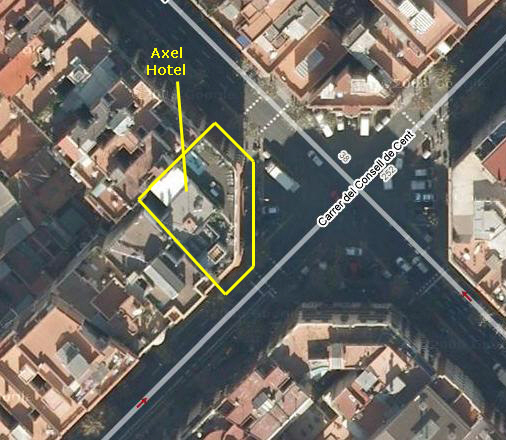 |
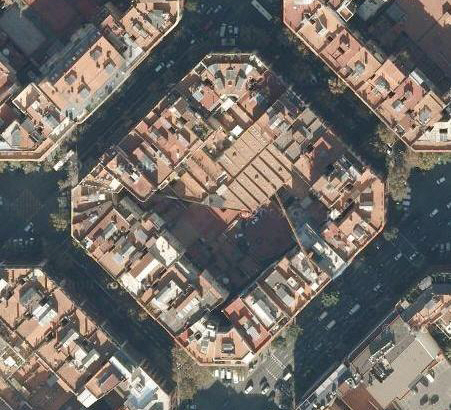
The interiors of the blocks seem to be of many different types. Some have parking and "common areas" and we also saw gardens and other separate and attached buildings. If you zoom out a bit and look at an aerial view of a wider expanse of downtown Barcelona, this block pattern becomes very striking:
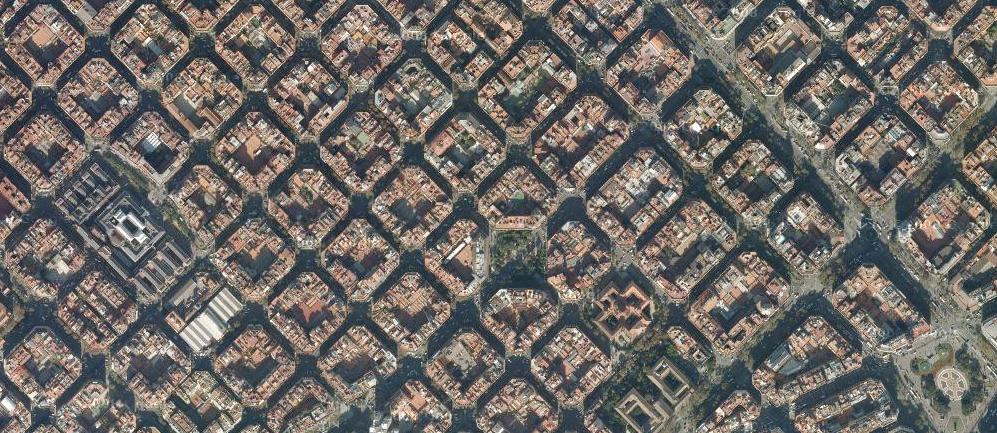
In and Around the Axel Hotel
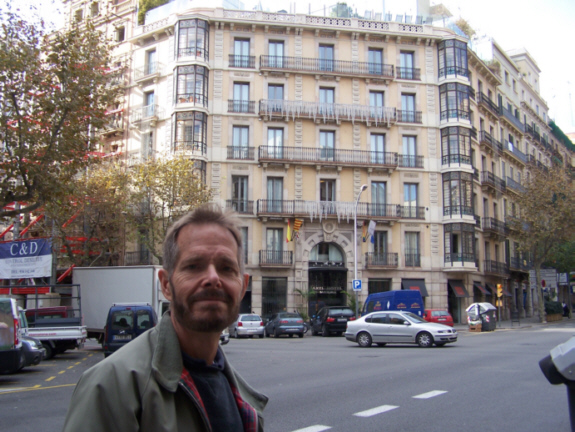 |
Our room was on the fifth floor; you can see which one it is in this floor diagram that was posted on the back of our room door. There was a queen‑sized bed that was quite comfortable, a desk and chairs and a wall storage unit that was very efficiently designed. The bathroom was not huge, but it was well-appointed and quite modern. In fact, the entire hotel looked as if it had just been thoroughly remodeled.
As you'll see in some of the pictures we took around the hotel, there is also a rooftop garden, spa and bar (not frequented at this time of year), and the view from this bar is pretty impressive.

|
During our stay, we took a number of pictures in and around the hotel. One of the most interesting things about Barcelona and its buildings is the extreme amount of detail that is characteristic of the outside of them. For example, click on the thumbnail image below to look at a closeup picture Fred took of a small part of the facade of one of the buildings across from our hotel:

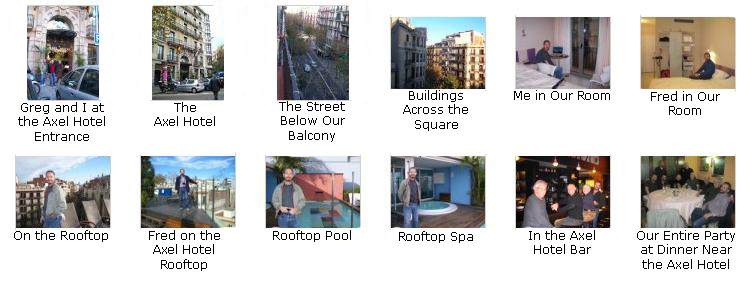
A Walk to Plaza Catalunya
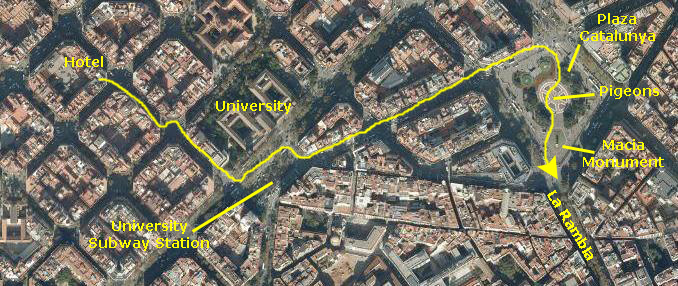 |
As soon as we entered the plaza, we passed by a beautiful fountain and statuary, and then crossed the broad tiled oval area in the center of the plaza. This is where we took pictures of the hundreds and hundreds of pigeons looking for a handout. At the south end of the park, there was another fountain and the Macia monument.
On the way to Plaza Catalunya and in the Plaza itself, we took some other pictures that we think you'd like to see. If you click on the thumbnail images below, you can take a look at them:
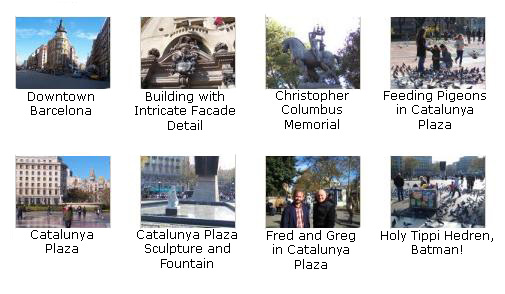
|
|
A Walk Down La Rambla
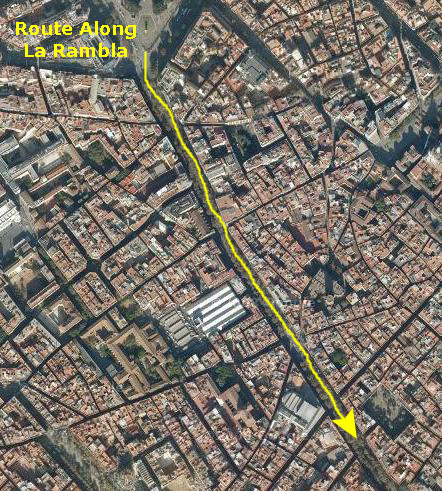 |
La Rambla can be considered a series of shorter streets, each differently named, hence the plural forms Las Ramblas (Spanish) and les Rambles (Catalan). From the Plaça de Catalunya toward the harbor, the street is successively the Rambla de Canaletes, the Rambla dels Estudis, the Rambla de Sant Josep, the Rambla dels Caputxins, and the Rambla de Santa Monica. Construction of the Maremàgnum in the early 1990s resulted in a continuation of La Rambla on a wooden walkway into the harbor, the Rambla de Mar.
La Rambla can be crowded, especially during prime time tourist season. Most of the time, there are many more tourists than locals occupying las Ramblas -- this has changed the shopping selection, as well as the character of the street in general. For this reason also, it has become a prime target for pickpocketing.
Spanish poet Federico García Lorca once said that La Rambla was "the only street in the world which I wish would never end".
The name rambla means, in Catalan, but also in Spanish, an intermittent water flow, and is derived from the Arabic 'ramla' which means 'sandy riverbed'.
The mall is actually a very wide paved median between two streets, and it is always busy, with vendor stalls all along its length, plus street performers and other attractions and activities. The two one-way (in opposite directions) streets between which it runs display a great deal of interesting architecture, and the side streets that branch off of it were certainly enticing. We took quite a few pictures while walking along La Rambla with Greg this afternoon. The first three in the first group are views of La Rambla itself, and the others are views of some of the more interesting buildings along this pedestrian mall. Click on the thumbnail images to have a look at these pictures:


|
|
Mercado de San Jose (Market)
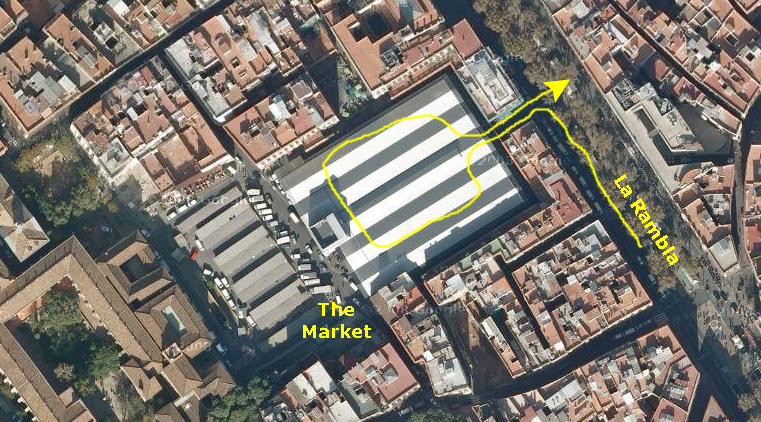 |
Indeed, when we got into the market area, we found it to be something like a large "farmers' market" affair. I guess I expected vegetables and other produce, and there were certainly fruits and vegetables in abundance, but there was an amazing variety of other stuff as well.
In addition to the fresh fruits and vegetables, there were vendors who seemed to specialize in prepacked drinks and juices and a host of other things, such as fresh fish and all kinds of crustaceans. We could easily see that the Spanish diet included a lot of stuff that I wouldn't eat on a dare. For some reason, I just dislike having food look back at me; I have no idea how any of this stuff would be prepared. Actually, there were also quite a few stands where the vendors were preparing the food and people would stop to eat at a kind of lunch counter.
This market obviously offered a lot of picture-taking opportunities, and if you will click on the thumbnail images below you can see some more of the pictures we took here:

Typical Barcelona Side Streets
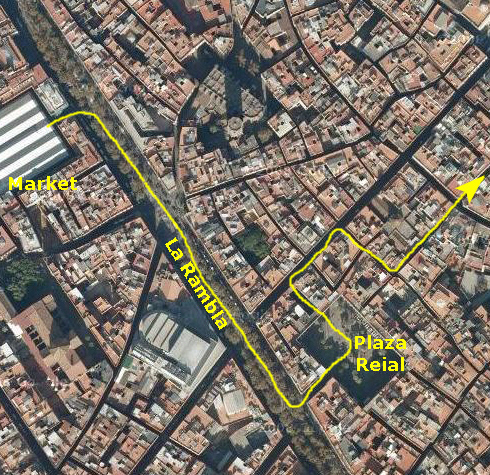 |
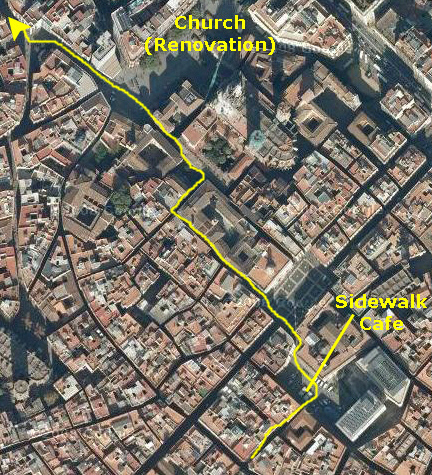 |
I should probably say something about street names here in Barcelona. Not counting the expressways which, like everyplace else, are numbered, the largest and broadest streets are called "Gran Via Something." Major streets are just "Vias." Next down from that, and by far the most common, are the "Carrer," which would correspond to our streets. These "carrer" may be quite narrow. But there are even narrower passageways between the carrer and between buildings, and these are called "passages" (same as our word). All over town, there are squares and plazas, and most of them carry the designation "Placa," as in "Placa Catalunya."
The Placa Reial was quite large, and was bordered on all sides by apartment buildings. There were lots of shops and cafes all around the square. I think it is these community squares that give Barcelona a lot of its ambience. When we'd looked around the square we went through a "passage" to Carrer de Feran; this passage seemed more like an atrium surrounded by apartments than anything else. Then we continued walking through big streets and small working our way northeastward. These small streets were immensely interesting, with all kinds of shops and stores and even the occasional small museum.
We eventually walked through another open square and almost stopped at a sidewalk cafe, but it was way too chilly to sit outside. We turned northward (following our internal GPS to head back to Placa Catalunya), walked through a narrow passage and underneath a double-level arched walkway, and then came out into another square. Here, hard beside an old Medieval wall, we found an old church being restored. It was here that we found the schoolkids having their afternoon snacks (see the pictures below).
All along this route, we took lots of pictures. The lighting was tricky in the dark side streets, so not all of the pictures turned out. I've included clickable thumbnail images below for the best of these pictures; have a look at as many of them as you wish:
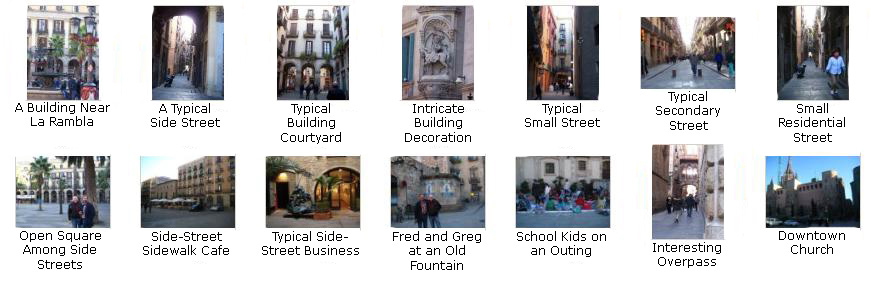
|
|
Back to the Axel Hotel
Anyway, we got back to Placa Catalunya and then headed back to the Axel Hotel, basically retracing our route from earlier. The only different thing we did was to stop in an Internet Cafe so Greg could check his email. The Axel has some shared computers, we later found out, that have free Internet access, but it isn't available in the rooms.
Below are some thumbnail images for the pictures we took on this last leg of our walking tour; click on them to see the full-size pictures:

|
|
This evening, many of our "tour group" were arriving, so we spent the early part of the evening meeting them and having drinks in the bar. After that, we all went out to have dinner together at a neighborhood seafood restaurant. Greg, gracious as always, treated us all.
You can use the links below to go to another photo album page.
 |
November 29, 2008: Barcelona (Day 2) |
 |
November 27, 2008: Copenhagen (Day 2) |
 |
Return to the Europe/Cruise Trip Index |